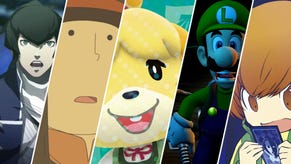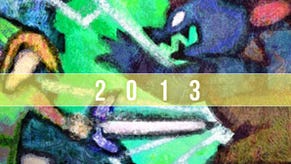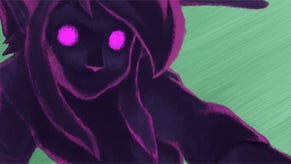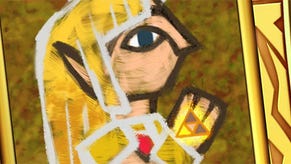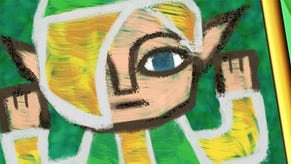A Link Between Worlds 3DS Review: A Worthy Sequel to the Greatest Zelda?
Does the newest Zelda live up to the legacy of a definitive classic like A Link to the Past? Jeremy Parish and Mike Williams hash it out.
This article first appeared on USgamer, a partner publication of VG247. Some content, such as this article, has been migrated to VG247 for posterity after USgamer's closure - but it has not been edited or further vetted by the VG247 team.
Primary Reviewer, Jeremy Parish
I've always found the hermit crab to be one of nature's most fascinating creatures. Like most crabs, it goes about its life wearing a shell for protection from predators and the occasional blunt trauma; unlike its cousins, though, the hermit crab doesn't grow its own shell, instead scavenging for shells left behind by other creatures.
I mention hermit crabs not because they're particularly relevant to the story or action of The Legend of Zelda: A Link Between Worlds, but because the game itself is a hermit crab of sorts. While the story, dungeon puzzles, and even the flow of the action are entirely new, all of those features took up residence in the shell left behind by The Legend of Zelda: A Link to the Past.
Come to think of it, I suppose crabs are relevant to the action. You know the green-shelled crabs that scuttle around the east and south areas of A Link to the Past's overworld? Those guys appear again in exactly the same places, with exactly the same behavior. The same can be said of just about every other geographic detail and over world enemy in A Link Between Worlds. Even dungeons, which have been reconfigured inside and out, borrow liberally from A Link to the Past; the palace in the southwest desert/swamp has a secret passage onto the rear cliff where you can find a Piece of Heart, while the one in the alternate world's Lost Woods has multiple entrances and exits you'll need to navigate (including secret entrances that must be revealed beneath bushes). You'll even escort a captive girl through the dungeon in Thieves' Town.
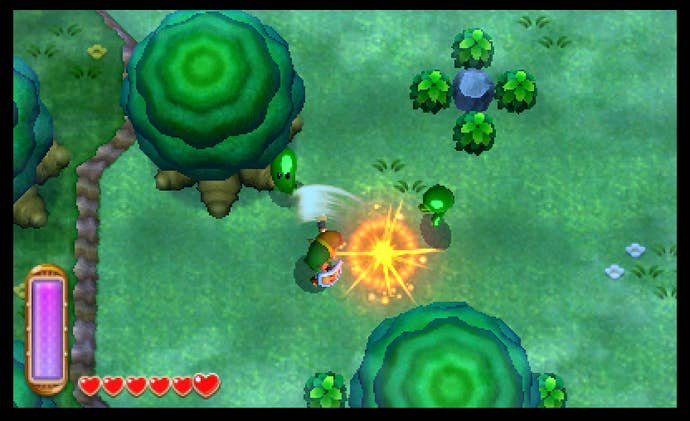
This familiarity makes for a very strange experience. A Link Between Worlds has been positioned as a sequel to A Link to the Past (in Japan even more so -- it shares A Link to the Past's original Japanese title with a "2" affixed to the end), but in truth it's less a sequel and more like a Second Quest. Frankly, it's long overdue. I was a little disappointed when I beat A Link to the Past for the first time, because great as the game was it came to a conclusive ending once the credits rolled. There was no extra-challenging remix as with the original Zelda, nor even a new-game-plus opportunity to steamroll everything in your path as with Zelda II. So really, this is just Nintendo coming up to speed 21 years later, finally giving A Link to the Past its post-game remix.
In a way, A Link Between Worlds reminds me of Oracle of Seasons, which was a remake of the original Zelda that became its own new creation somewhere along the way. If an Iwata Asks were to reveal that this sequel began as a 3D recreation of A Link to the Past but mutated into something different (perhaps when Nintendo realized that putting out two Zelda remakes in rapid succession would amount to overkill), I wouldn't be at all surprised. That would certainly explain why the geography of the Kingdom of Lorule is exactly the same as A Link to the Past's Dark World (minus the pyramid in the center), even though the Dark World was Hyrule's corrupted Sacred Realm whereas Lorule is, well, something else entirely. Far be it for me to demand continuity in my Zelda games, but the story here feels a little too tragically half-baked not to make note of.
And yet, even though A Link Between Worlds amounts to an adventure awkwardly (and unattractively) wearing its predecessor's skin, it still manages to stand on its own merits. You could easily write it off as a mere rehash of a classic, a quick cash in on nostalgia, but there's more here than a masterpiece co-opted for an easy money grab. It's a rehash, yes, but it's also an interesting exercise in formal design -- an experimental inversion of A Link to the Past's previous sequels.
Even though A Link Between Worlds amounts to an adventure awkwardly wearing its predecessor's skin, it still manages to stand on its own merits
The sole 16-bit Zelda adventure brought together a lot of design concepts that other action-adventures (including its two predecessors) had explored in loose, uncertain, imperfect ways, and it did so with such elegance and skill that the series has never quite shaken off the template it established. Nor has the genre, for that matter. And that's what makes A Link Between Worlds so fascinating; where other Zelda games copied A Link to the Past's structure and progression wholesale and simply created new worlds around it, this sequel duplicates its world but gives you an entirely new way to play.
The shop feature has seen much ballyhoo -- the idea that rather than finding key tools and subweapons in a dungeon whose puzzles and boss are conspicuously designed around its application has been integral to Zelda since 1992. But this sequel throws it away entirely. Yes, completing each dungeon requires a specific tool, but you can rent or buy these items freely from a shopkeeper who sets out his wares in Link's living room. This means you can effectively outfit yourself with the complete Zelda arsenal right from the beginning and tackle dungeons in any order (provided you can find your way to them through the elaborate puzzle that is the dual world of Hyrule and Lorule). Not only do you have instant access to all those tools, but Link also gains the most fundamental power in the entire adventure -- the ability to impress himself onto walls and traverse flat surfaces at will -- at the story's outset.
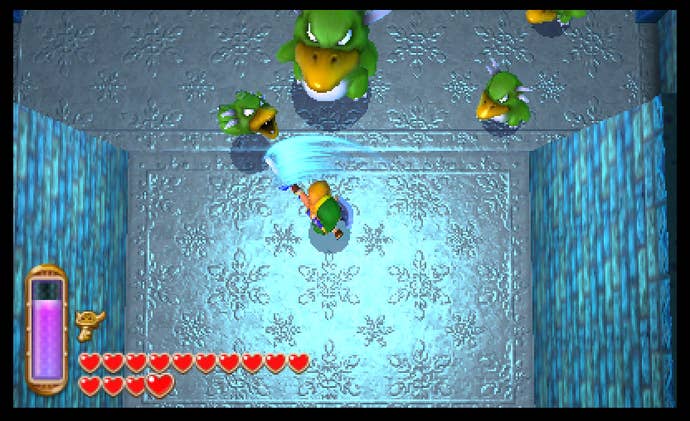
Though you don't have absolutely unfettered freedom to go where you will, as you need to complete a trio of dungeons before unlocking the other seven (yes, just like A Link to the Past), the overall effect isn't too unlike that of a Mega Man game. As in Mega Man, you can tackle your choice of "levels" at will, and knowing the right weapon for the boss makes things vastly easier. But also as in Mega Man, bringing non-essential weapons can give you a further advantage. A certain dungeon may not require you to bring along the Flame Rod or Ice Rod, but you'll find many foes and even puzzles go down far more quickly if you do.
The rent-or-buy structure places heavy emphasis on gathering money, but this turns out to be nothing like the chore it was in Wind Waker's Triforce map quest. For starters, the purchase prices are pretty reasonable -- I spent about 10,000 Rupees in the course of the game for everything (not just weapons), but ended up gathering about twice that amount. Large-sum Rupees are everywhere, and there are plenty of other ways to accumulate wealth besides. In the early going, I found catching and selling bees was a quick route to riches. And rentals aren't a bad way to go; once you rent something, you keep it until you die. Falling in battle and being revived by a bottled faerie doesn't count as a death, which means that since I only had to continue once, I only lost my rental gear a single time in the course of the adventure -- a fairly risk-free venture. (Though maybe less so in the extra-hard Hero mode that shows up after you beat the game.)
The fact that you can rent Link's basic tools doesn't mean A Link Between Worlds lacks for things to discover besides cash. Within the world you can find better armor, a means to double your magic meter, ore for upgrading the Master Sword, and more. Each dungeon contains a piece of gear worth tracking down, and a collectathon side quest allows you to boost the capabilities of the tools you've purchased by finding lost baby octopi called Maiamai. The Maiamai hunt is the first optional quest I've pursued to completion in a Zelda title since... wow, I don't know. I think I got all the Pieces of Heart in A Link to the Past once, maybe? It's fun and not at all tedious, testing your ingenuity, observation, and understanding of the duals worlds' structure.
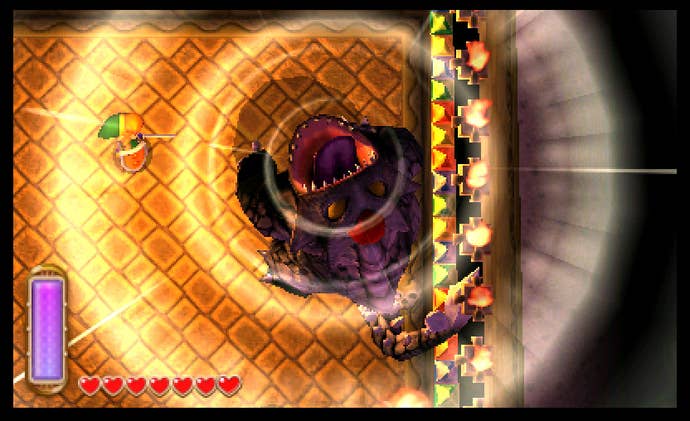
A Link Between Worlds' lack of a prescribed dungeon sequence means there's no particular level that's easier than another. Each labyrinth features its own central gimmick, and while some conceits may click more easily with you than others, I feel they're all equally complex. Nintendo's Zelda team has really aced the art of tricky dungeon designs with its portable outings, and the puzzles here leave even Spirit Tracks -- whatever you think of that game, it had fantastic dungeons -- in the dust. While much of A Link Between Worlds amounts to recycled material from a 20-year-old game, its dungeons (and even its overworlds) make those in A Link to the Past feel primitive and flat.
Speaking of flat, I can't emphasize enough how much Link's ability to merge into walls adds to the game. Even though A Link Between Worlds goes with a top-down perspective that effectively renders it a 2D game with layers rather than the properly three-dimensional adventures you see on consoles, it requires more than just two-dimensional thinking. Using the walls for traversal forces you to consider the construction of its dungeons and overworld in a way that no other top-down action game has. In other Zelda games, a raised block bridging a gap between two platforms would be an insurmountable obstacle forcing you to find a way to lower the block. Here, you simply press against the block and skirt around its perimeter from one side of the gap to the other.
Ultimately, I found myself entranced and irked by A Link Between Worlds in equal measures. Its devious puzzle design and open-ended structure marry the best of modern Zelda's complexity with the freedom of NES Zelda's "figure it out yourself" design. There's no hand-holding here, no annoying faerie companion to force clues down your throat, and I love it. On the other hand, the fact that it clings so slavishly to the generalities and specifics alike of A Link to the Past cheapens the experience considerably (though not as much as its hideous visual design does). I can try and guess what Nintendo was going for with the hermit crab design of A Link to the Past, but I can't help but be disappointed that producer Eiji Aonuma's oft-stated desire to evolve the series beyond its rigid formula necessitates such a dramatic, conservative backward step.
Secondary Reviewer, Mike Williams
While others may have loved Legend of Zelda through the ages, my devotion has trailed off. Twilight Princess seemed to be heading in the wrong direction, and for all of its excellent focus on the characters of Link's world, Skyward Sword bored me to tears. A Link Between Worlds stands as the opposite of Skyward Sword: There are characters here who you're given little reason to care about, but the journey is uniformly excellent.
For me, A Link Between Worlds harkens back to something even older than a Link to the Past. It evokes the feeling of exploration found in the original Legend of Zelda. That's because A Link Between Worlds rarely handholds you. It's amazing how much it makes you realize how you're used to having training wheels. You begin the game with a sword, but I wandered through the game for another couple of hours before it occurred to me to buy a shield. I just expected the game to give me a shield eventually.
Once you unlock the brand-new item shop, the game really takes off and gives the Zelda series a shaking-up that it's really needed. Nintendo fans are familiar with the formula: Tackle dungeon one, get item that will help you beat the dungeon boss and move onto dungeon two, rinse and repeat. Yes, A Link Between Worlds still has dungeons that are based largely around certain items, but those items are always available.
The item rental mechanic adds tension to the game. You can rent all the items at the shop, but if you die, you lose everything. It changes the focus from, "Do I have the correct item?" to "Is heading into this room with only two points of health the best plan?" Veteran Zelda players won't have many problems -- this isn't Dark Souls -- but it is a solid change to the soul of the franchise.
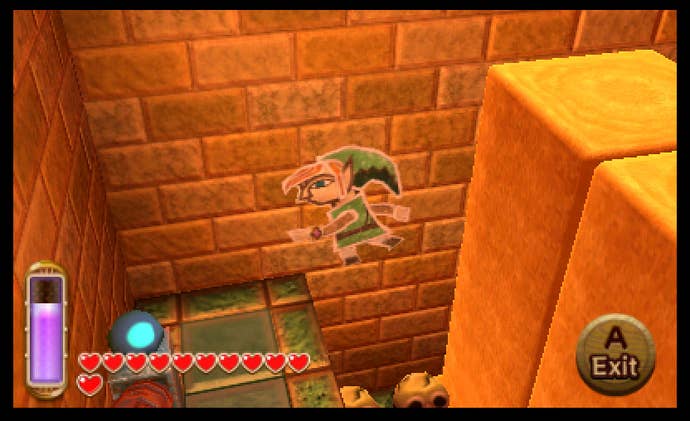
The change to the weapon system extends to ammo. There's none, because everything is powered by Link's energy bar, with certain weapons taking more energy than others. The bar refills on its own, but you have to watch it. Flailing around and using a weapon at random can leave you defenseless. The rental and energy mechanics forced me to be more measured in how I played the game. In fact, one of my deaths was because I ran out of energy due to reckless bomb use.
Jeremy is down on the visual style of A Link Between Worlds, but I disagree. I admit that it looks worse on his 3DS XL than my vanilla 3DS, but it's not the worst thing ever. Everything plays smoothly and the 3D effect is great. It's not as in-your-face as most titles, tending more on the subtle side. On some dungeons, the sense of verticality is really improved by the 3D.
The game plays great. Having missed the past few Legend of Zelda games for portable platforms, I was unsure if leaving the four-directional movement style behind was a new thing; whenever it left, it won't be missed. This gives you more options in dungeon encounters. Certain switches can only be reached by aiming at the right angle with your bow or boomerang and it's satisfying to make a tight curve to dodge an enemy. This style of movement has existed in the console Zelda games, but A Link Between Worlds doesn't have to worry about one issue in those games: Targeting. The game uses an overhead perspective, so the problem of aiming becomes a non-issue. Point Link at a mob, and go for it.
A Link Between Worlds impressed me. It's probably up there with my favorite Zelda games, Ocarina of Time and Link's Awakening. It may even be better, but nostalgia is the fog that clouds up my view into the past, so I can't be certain without returning to those titles. Either way, it's a big improvement on the Zelda presented in Skyward Sword, and I hope Nintendo takes some of the mechanics from here into the console versions.
ConclusionA Link Between Worlds takes some much-needed strides to shake things up. But it does so within a pair of worlds most fans know maybe a little too well, and you know what they say about familiarity. This is a good first step in Nintendo's journey to revitalize Zelda, but the next leg of the trip needs to be considerably bolder.

